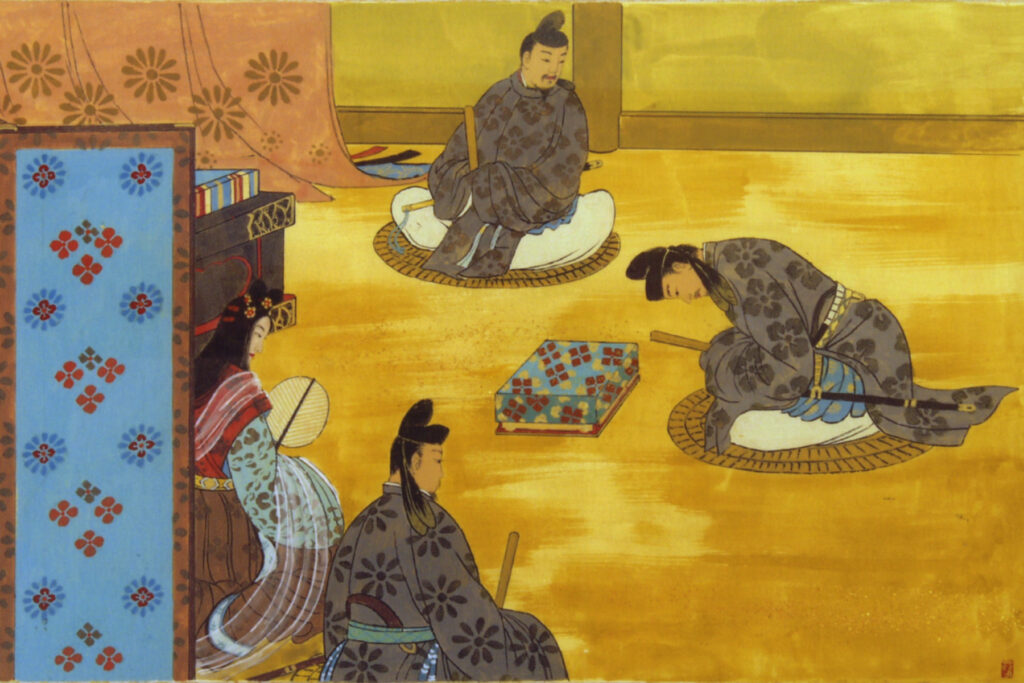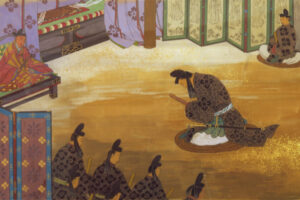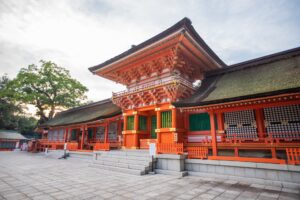The Dōkyō Incident, Part II – Exile and Restoration
道鏡事件 後篇 ― 流罪と復権
After his exile, Wake no Kiyomaro was eventually restored to honor. Summoned once more to the court, he carried the dignity of a man who had risked everything to defend the imperial line. His restoration was not only personal vindication but also a reaffirmation of the principle that legitimacy, not ambition, must guide the throne of Japan.

A painting depicting Wake no Kiyomaro bowing deeply before the court upon his restoration, while officials and attendants look on. This moment symbolizes his vindication and the reaffirmation of imperial legitimacy. (Source: Wake Shrine, 1385 Fujino, Wake Town, Okayama Prefecture, Japan – https://wake-jinjya.com/)
Introduction – From Court to Exile
When Wake no Kiyomaro returned to the capital with the true oracle of Usa Hachiman, he knew the risk. To deny Dōkyō’s ambition was to defy a man who stood at the pinnacle of influence, backed by the empress herself. Dōkyō responded with fury. Kiyomaro was stripped of rank, shackled, and exiled to Ōsumi Province in southern Kyushu. His legs were even slashed to prevent him from walking proudly through the capital again.
Yet even in humiliation, Kiyomaro’s resolve did not waver. His exile became a testimony to loyalty—a silent act of resistance against the corruption of the realm.
Hardship on the Road
The journey to Ōsumi was long and cruel. Guarded like a criminal, Kiyomaro endured hunger, pain, and the jeers of those who saw him disgraced. Yet legend tells that divine protection accompanied him. A white boar appeared along the way, guiding him safely through the wild mountains, as if the gods themselves affirmed his mission.
Meanwhile, in the capital, Dōkyō’s arrogance grew. He demanded to be made emperor, but resistance within the court deepened. The oracle Kiyomaro had brought back could not be ignored, and the legitimacy of the imperial line remained a powerful shield.
Turning of the Tide
In 770, fate shifted. Empress Shōtoku passed away, leaving Dōkyō without his greatest ally. The court quickly moved to strip him of power and send him into exile. In contrast, Kiyomaro was recalled from Ōsumi and restored to honor. His loyalty, once condemned, was now celebrated as the very act that saved the imperial line.
This dramatic reversal revealed a timeless truth: authority built on ambition alone collapses, while fidelity to principle endures.
Legacy of Restoration
Kiyomaro’s exile and return became more than a personal story of suffering and vindication. It established a precedent: that the throne of Japan is not to be decided by force, wealth, or clerical influence, but by the unbroken line of descent. His steadfastness laid the moral foundation for later generations of warriors and statesmen who upheld the same principle.
In this way, Kiyomaro’s ordeal was not merely a clash with Dōkyō—it was a reaffirmation of the Japanese polity itself. His courage in the face of exile, and his ultimate restoration, ensured that legitimacy triumphed over ambition, and that the people, the ōmikura, would remain under the protection of the true imperial line.
Conclusion – The Enduring Lesson
The Dōkyō incident, in both its rise and fall, shows us how fragile a nation becomes when ambition outweighs principle. But it also reminds us that individuals of integrity, even in disgrace and exile, can preserve the sacred thread of continuity.
Wake no Kiyomaro’s story echoes across the centuries: to stand for legitimacy is to stand for the people, even when the cost is exile, pain, and scorn. And when legitimacy is restored, so too is the nation’s heart.


